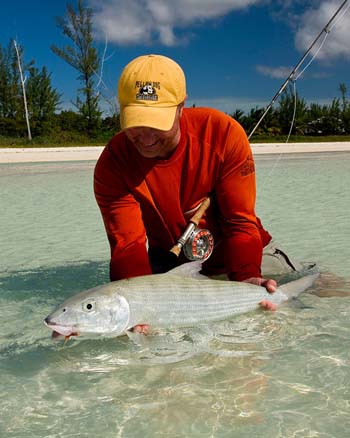
What the Hell are we doing to ourselves? I’d rather be bonefishing.
Pros weigh in on what is involved sight fishing for the perfect game fish, bonefish
By Skip Clement:
Contributors: Captain Andrew Derr / Tom Karrow, Ph.D. / Chico Fernandez / Peter McLeod / Aaron Adams, Ph.D. / Sandy Moret / Jim Klug / Angie Roth
NOTE: Names in the following account were changed, but the conditions, situations, destinations, and equipment needs are actual. The story is a compilation of events that happened to the author in years of experiencing the Bahamas.
NOTE: Others will have had different experiences and are encouraged to comment.
The story, a fiction-sort of
All three men were excellent fly casters; Pat Philbin, Caesar De La Hoya, Chicago lawyers, and hard-core trout fishers. The third excellent caster was their guide, James Neymour, a native Androsian Bahamian, schooled in the art of bonefishing as is an older brother, father, and an uncle that had been. He was happy to have two good fly fishers onboard and being lawyers, a complete surprise that they paid attention to instructions without comment or cross-examination.

Are you sure this is where she said the bus stops? Photo: Jim Klug – Yellow Dog Flyfishing.
The value of amateur-chosen flies
This trip was the lawyers’ inaugural bonefish outing, and they came well-prepared, having watched dozens of videos and solicited comments from others with some experience. They brought at least a dozen fly boxes full of bonefish flies. Neymour, their guide, left all but one box of flies on the dock on the first day. He scrounged six Gotchas, a few Bitters, three CI Specials, and two Mantis’ from the Chicago box collection and discharged the rest, and off they went with no grumbling, just hardy laughter enjoyed by all.
The first outing
Earlier in the first week, Philbin and De La Hoya each lost nice fish by failing to cast early enough to get a fly benthic before the schooling bones arrived. Bonefish are down-looking fish. Any frontal observation, even side view reveals that fact; they do not look up to feed. However, while contradictions are rare, bonefish move up in the water column to take flies.
Each angler also lost a couple of nice fish on tailing bones feeding up against mangroves. This time, they attempted trout setting [an instinct even when knowing better] their fish by lifting their rods, succeeding only in pulling the fly out of hungry mouths, which also ensured that because of the splash, there would be no redo because it spooked ‘all’ the near bonefish. The location closed for business for an hour or more.
It was mid-February, and a cold front from Florida had sputtered in South Andros but still created enough wind gusts to be a consideration and influence fishing. Neymour fished his clients in protected water but had them go from sevens to eights, heavier Gotcha flies, and fish darker colors because of the tainted water due to three days of wind.
Neymour had his clients use the Belgian cast due to wind, but only the first two mornings
It was Thursday, four days into his client’s stay. Neymour was pleased with the clearing water, calm winds, and his clients’ improved recognition of sink rates coordinating with intercepts of Albula in all profiles, schooling, mudding, and tailing – including tide-made water depths. But most importantly, Neymour succeeded in teaching setting the hook via strip-strike.
Neymour had Philbin and De La Hoya stay with Gotchas, sometimes dressed slightly different, slightly lighter or heavier, and darker or lighter to meet conditions. Neymour knew a complete change of flies would require learning new sink rates and a lot of missed fish in that learning curve. But, because of their success, he threw in rust-colored bitters in a grassy stretch and mico shrimps in another area known for its persuasiveness. The weights of the flies and water depth require learning.
Big singles and doubles were plentiful in South Andros. Both Chicago lawyers had landed double-digit bones, including many smaller examples that filled each day with bragging rights during cocktails.
Two surprise Megalops atlanticus hookups by De La Hoya became the Fox News cocktail hour talk, embellished. They even tried to rewrite some events. Neymour had heard it all many times before – so used to catching enrichment storytelling he could only laugh.
Learn to Belgian cast . . .
Megalops enters the fray
Neymour said the two tarpons brought to hand were each in the 30-pound range; a third ‘Buttkickus fishus’ was lost to a trout set attempt by Philbin, who lamented the mistake as if he’d swallowed hemlock.
Neymour quickly had De La Hoya using the rod butt and flexed legs to turn and lift the tarpons that would ordinarily outgun 8-weights. Florida Keys guide discovered a way to shorten fights even when under-armed by using the Keys’ fighting style. It tires the fish by not allowing it to gulp air [turn and lift].
Neymour also warned De La Hoya how to survive boat-side energy bursts so common to gamefish, especially tarpon – let it run against the drag until it rolled on its side, get a photo, and leave the tarpon in water.
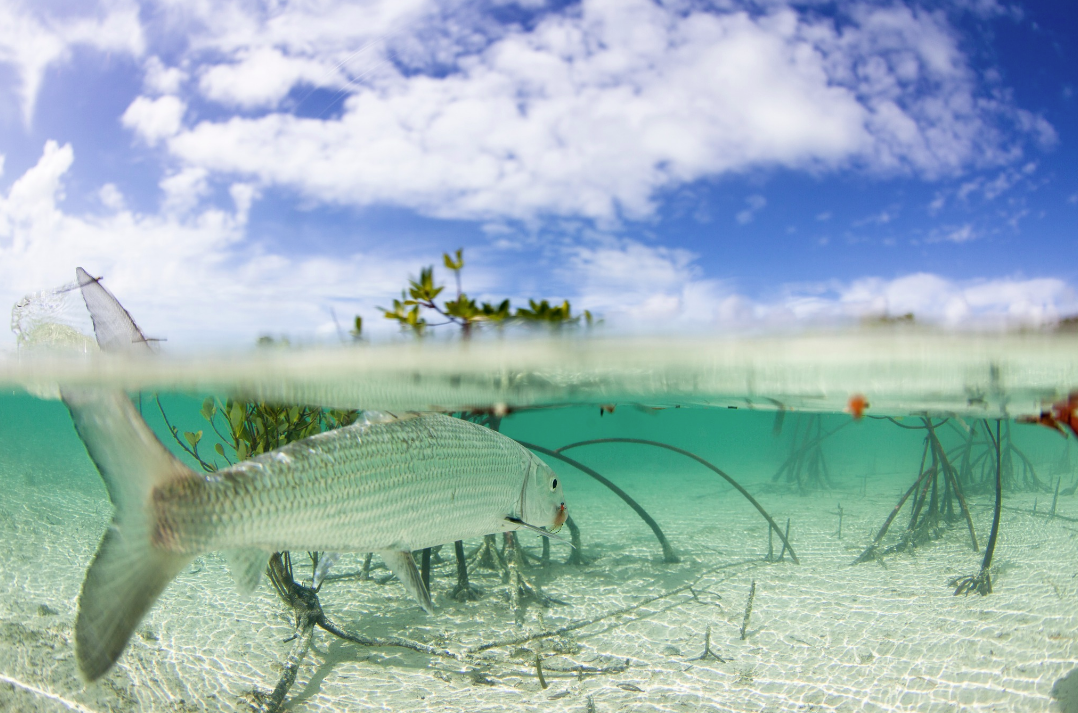
Photo: Jim Klug – Yellow Dog Flyfishing Adventures.
As Captain Derr points out
The misinformation about bonefish anglers needing to cast 80- to 120-feet to be serious bonefishers is false and needs to be corrected. Derr said, “If you can cast accurately, you will only need to cast 30- to 60-feet to catch bonefish. The casting ‘trick’ is accurate enough so that discovery intercept of your fly is a twitch at benthic rest, giving the bonefish a seeable sand-puff, which generally gets distinctive eat in the grass, marl, sand, or coral mix with grass and sand by the ever-up-tide traveling look-down bone feeding on mollusks, worms, shrimps, crabs or other local temptations.”

Click on logo . . .
Bonefish are the quintessential sight fishing experience
A well-cast fly that’s a decent mimic of a worm, shrimp, or crab that has been laying still on the bottom and then given a short twitch to create a puff of sand/mud at the near intersect of fish and fly has more than an even chance of instigating an eat. And if it does not at first look, a persistent angler giving subsequent short twitches can sometimes a return eat.
Albula has many unique and one-off characteristics
First, Albula only lives in beautiful places; second, usually a sighted experience; third, an aggressive feeder in all of the previously mentioned profiles; and lastly, the bonefish is like no other fish on the flats or freshwater animal on the planet:
Albula vulpes can leave the scene at a startup speed of more than 40 mph. A hearty freshwater fish, maybe seven mph.
Albula has many unique and one-off characteristics
First, Albula only lives in beautiful places; second, usually a sighted experience; third, an aggressive feeder in all of the previously mentioned profiles; and lastly, the bonefish is like no other fish on the flats or freshwater animal on the planet:
Albula vulpes can leave the scene at a startup speed of more than 40 mph. A hearty freshwater fish, maybe seven mph.
Foods and flies: Aaron Adams, Ph.D.

Aaron Adams, Ph.D., at a 2013 BTT Symposium held at the International Game Fish Association headquarters in Fort Lauderdale/Dania Beach, Florida. Photo by Skip Clement.
According to Adams, Director of Science and Conservation for Bonefish & Tarpon Trust and a Senior Scientist at Florida Atlantic University Harbor Branch Oceanographic Institute, and skilled fly fisher, bonefish are opportunistic feeders and take advantage of a great diversity of prey found worldwide on all of their shared and primary feeding grounds, shallow water flats: crabs, shrimps, fished, worms, clams, snails, brittle stars, and anything encountering Albula, which ends in a bad day, and within any one location, several varieties of each of the latter mentioned food types.
- For example, in a recent study in the Florida Keys, well over 127 species of prey were recorded in the stomachs of 385 bonefish
With their subterminal mouths, bonefish are best adapted to feed on benthic organisms such as crabs, shrimps, clams, and worms. That said, they are also adept at catching mid-water prey like baitfish. For anglers to create a list of prey is worthless – just too many choices, so why do some flies work better than others in different locations at different times of the year? The short answer is that bonefish have a varied diet but have preferences for particular prey that vary with habitat and time of year.
- So, an angler would ask, of all things that bonefish eat, which ones are worth imitating with a fly?
Bonefish do not live to eat but instead eat to live and, as such, are, therefore, opportunists first. For example, the diets of bonefish studied in the Bahamas and small clams dominated Puerto Rico. In contrast, clams and their relatives were second to crustaceans [crabs and shrimps] in bonefish stomachs in the Florida Keys.
A bonefish takes advantage of the habitats that tides, temperature, weather, predators, boat traffic, and other human activities allow it to access and feed on whatever prey it finds, albeit somewhat selectively.
- There is little need for dozens of different shrimp patterns in your fly box
Scientific studies of bonefish diets break the prey into small, explicit groups – different shrimp species, for example. Unfortunately, while necessary for studies of bonefish ecology, the differences among many of these ‘classified’ species, like shrimps, are often so slight that a single fly could imitate many of them.
The construction of a fly, its size, weight, and coloration, and, more importantly, how it is presented makes a difference between an eat and a rejection.
- Many organisms found in bonefish stomachs are hardly abundant
For example, in a Florida Keys research project, only eight of the sixty-one prey organisms recorded in bonefish stomachs occurred in more than 10 percent of the stomachs. In other words, a small group of prey dominated the diet, but they ate a lot of different types of prey.
NOTE: If you are a DIY bonfisher traveler to foreign lands, bring a trunk full of said-to-be bonefish flies. Hey, one may work, but which one?
Sandy Moret
NOTE: Sandy won five Islamorada Bonefish Fly Fishing Tournaments
In 1989, Sandy Moret put together his first saltwater fly fishing school. It would become, hands down, the best in the world. But, always a businessman, he began to realize the school’s attendees wanted more. They wanted to fish, they needed flies, and the business grew vertically.
In 1994, he opened a full-service fly shop, Florida Keys Outfitters, and never looked back.
Sandy has won many fishing tournament titles, the most significant wins being five Islamorada Bonefish Tournaments. He has also held positions he was either elected or appointed to prestigious and influential Everglades and Florida environmental issues and remains a keen and outspoken proponent on those matters environmental.
For those who watched ESPN’s Walker Cay Chronicles, you saw Sandy as a guest angler with his friend flip Pallot and on the TV show Reel Guys. Sandy has also written the foreword to books, and his articles on saltwater fly fishing and wing shooting appear regularly in sporting publications.

Photo: Jim Klug – Yellow Dog Flyfishing.
Sandy is the past president of the Everglades Protection Association and served on the East Everglades/Everglades National Park Advisory Board at the appointment of Governor Bob Graham. He is a founding member of Bonefish & Tarpon Trust and past Chairman of The Don Hawley Foundation (Guides Trust Foundation). In 2018, Sandy was awarded the Fly Fisherman Magazine – Sage Conservationist of the Year and presented with The Orvis Company Lifetime Achievement Award for his work with the Now or Neverglades Movement. He is on the Board of Directors for The Bonefish & Tarpon Trust and Bullsugar.org.
Never feel bad for Sandy is on the water laying down a line at least 80 or more days a year. Sandy’s favorite pursuit is the flat’s ghost itself, along with the laid-up tarpon.
Sandy on casting
The limiting factor, for some reason, is the hesitance to put in the time to develop the casting skills to catch these fish. Bonefish are demanding and maybe a bit more complicated than others, but some days they are dumb as stumps. Therefore, you must bring good casting skills anywhere in the salt.
Casts of 40- to 60-feet in the wind are the minimum. I wonder if I can cast 80-feet. There are a lot of great casters in the world—more than there have ever been. Still, many people don’t devote the energy to fine-tune it. The cast is a huge part of catching bonefish.
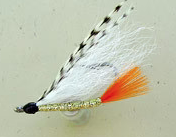
Chico’s Bonefish Special.
NOTE: Moret’s best bonefish fly is Chico’s [Fernandez] Bonefish Special.
What about fly rods?
The technology on rod development continues to change, and people’s casts continue to change. So if I pick up a rod and use it for 4-5 years, I pick up a new one and say, “How could I ever have lived without it?”
— Interview with Sandy by Bjorn Stromsness
I can cast 90-feet with the double haul accurately on a lawn in ideal conditions, but only able to cast 60-feet, accurately from the deck of a skiff in less-than-favorable conditions.
But if given a few index cards of information on how to fish for anything, with a guide, I would do well in the catch department.
It would be best to cast accurately and within your range, with the best wind conditions and visibility possible. The targeted fish should only sense your presence to a degree until he feels the hook. — Angie Roth
Chico Fernandez
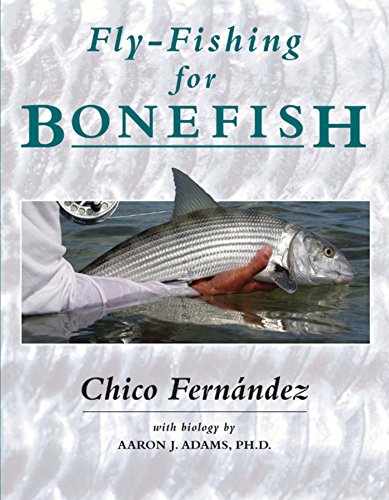
Click here to get this must book for bone-fishers.
Note: The following are excerpts from Fly Fishing For Bonefish [2004] and as presented in Close to the Bone, March 10, 2011 [Midcurrent]
If you are fishing a flat by boat, the first cardinal rule is don’t run the skiff all the way into the flat. Even an idling engine will spook bonefish for many hundreds of yards.
Instead, if the surrounding water is shallow enough, stop 100 yards or more from the edge of the flat and quietly pole in. During that time, anglers can prepare the tackle or train their eyes to the water. So, when you hit the edge of the flat, your angler is ready. And often, the best fish of the day will be on that first flat early in the morning.
Because sound travels better through water than air, any noise that comes from inside or outside the skiff is deadly. The constant slap of waves against a hull, dropping a pair of pliers on the bottom of the boat, or closing one of the hatches too loudly can all send a bonefish to the next flat.
Rocking back and forth during your false casting also rocks the skiff, creating a series of bow wakes with every false cast. Bonefish can detect these wakes very quickly, even the faintest ones, and may stop feeding or leave.
Approaching a fish early or late in the day can often throw a long shadow, which tends to spook bones. So try not to cast your shadow in the fish’s direction. To be consistently successful, everything that could go wrong should be made right before you even cast.
Fear Factor
Not every bonefish that senses the skiff or an angler leaves the flats in a rush. Sometimes, the bonefish suspects something is wrong, but he keeps feeding more or less normally, possibly even moving toward you.
I find that there are degrees of spookiness; not every bonefish that senses the skiff or an angler leaves the flats in a rush. Sometimes, the bonefish suspects something is wrong, but he keeps feeding more or less normally, possibly even moving toward you. Here it is best to cast away from the area of awareness so that your fly drops in less intrusively.
But if the bone is so aware that he is constantly moving away from you as you pole and cast, you should let him go, calm down, and start looking again. If you have disturbed a large school, you could try one last cast to the side and hope a couple of fish break away to chase the fly. But good luck.
And remember that you are not the only predator on the flat. The proximity of sharks, barracudas, or birds can quickly change a bonefish’s appetite, so you must always try to read the fish’s body language as he swims or feeds. With time, you’ll be able to tell if he is happy and feeding or if he is stressed. And while you may not be able to relieve his stress, you’ll know to be more careful and cast a little bit farther so as not to spook him.

Photo: Jim Klug – Yellow Dog Flyfishing.
Telling Tails
A bonefish tailing in shallow water can be incredibly nervous – very sensitive to sound, movement, or shadows, any of which could be a predator. And to find his food, he generally has to push his face against the bottom, so he can’t always watch out for danger. And if the bottom has long turtle grass, his area of awareness is further limited.
Now add that you must cast very close to the fish without spooking him. At the same time, you have to approach closely enough to ensure such accuracy and close enough that you can pick up and try again if you miss your cast. Finding that fine line between being too far to cast and too close to fool the fish can be nerve-racking.
Fly fishing for bonefish
If you can determine the approximate direction he is feeding, which is often into the tide, you can cast a bit ahead, leave the fly still, and let him move toward it. Then, when you judge that he has the fly within his area of awareness, twitch it just enough to get his attention.
Also, while most flats require that you use your wading boots to protect yourself from the many sharp and hard structures and animals in that environment, there are some flats, such as in the Bahamas and some areas of the Yucatan, that are firm and sandy enough to wade barefoot. The latter is the quietest method of wading, but be sure to ask your guide to ensure it is safe to do so in that area.
Cruising Fish
Because cruising fish are generally in much deeper water than tailers, and because they are looking out and not down, they have a much larger area of awareness. Here the window of opportunity can be from about two feet to more than six feet, depending on depth.
Suppose a cruiser is going to the left or right, cast in front of and maybe a few inches past him, but no more than that. If you cast well past his line of vision, even if the cast does not spook him, and you start to work the fly, you will be moving the fly toward him. This action is almost sure to spook a bonefish. I know it does not make sense for a 10-pound fish to spook from a 1-inch bait imitation, but prey moving toward a bonefish is unnatural to him. I have seen plenty of 6-foot tarpon spook from a 3-inch streamer moving toward them.
If you get a head-on shot at a bonefish coming more or less straight toward you, there are a couple of places to aim. First, you can cast a few feet in front and let the fish come to the fly, then start to retrieve, and it works fine, except that usually he will be facing straight into danger, and as he moves toward the fly and gets even closer, he could spook.
A better strategy is to cast slightly to the right or left of an oncoming fish so that when he does chase the fly, he is forced to move to one side, taking the boat or angler out of his view.
Mudding Bones
When a bone is feeding on a soft-bottom area, such as on an inside or bay-side flat, a visible, often compact mud occurs. A large school can create a very prominent and visible mudding area.
When fishing for mudding bones, you must determine in which direction they are feeding because the fish can be far ahead by the time you cast to the last mud.
Ideally, it is best if you can see the fish, which usually show quite dark in this environment. Then you can cast to an individual bone. But if you cannot see them, try casting a bit ahead of the last mud — even if you don’t see anything. You may be surprised by a hard strike.
Bonefish schools, sometimes very large schools, will also mud in six to ten feet of water in many parts of the world. It is not like fishing the flats, let alone sight casting, but it can be fun for a couple of hours.
I have seen deep-water mudding areas larger than an acre. You just cast on the most active part of this giant mud, which looks like a mud within a mud, and let the fly get close to the bottom. On several occasions, when I was in the mood and found such schools in deep water, I could land dozens of bones in just a couple of hours. It’s fun but no challenge, although sometimes that’s also okay.

Photo: Jim Klug – Yellow Dog Flyfishing.
Too Close, Or Not Too Close?
Within reason, different distances will work in the same fishing situation. For example, a good caster may start the cast sooner and throw 65-feet to a bonefish, whereas a novice may start later and end up casting only 45-feet — and still, both might catch the fish. However, chances are that day in and day out, the better caster will spook fewer fish and land more of them.
So practice, practice, practice. And when you can get some distance, say more than 60 feet, start practicing with a fly with the hook cut off. And then practice with the fly on the water. Allow yourself to make mistakes; be patient and enjoy it.
A good approach requires premeditation of all the above variables and more. You must ensure that the wind will not foul your cast and that the sun’s angle will not cast the wrong shadow or impede your vision at the bad moment. You must make sure that the guy poling is out of the way of the backcast. How close will you let the fish get to you — or how far away — before you initiate the cast? And exactly where are you going to place the fly?
With some practice and experience, all the questions and answers will become second nature so that you are simply “doing” as much as thinking about what you are doing. And when you finally slip your hand over that big fat bonefish, the feeling of accomplishment is great. Although, after taking a few thousand bonefish myself over many years, I still don’t take any part of the pursuit for granted.
Bonefish are the first species to move onto the flats. Bonefish moving into the tide defeat skinny water predation by barracudas and sharks too big to access early tidal flooding of flats. Anglers observing the flats on foot or from a guide polled skiff will notice holes over much of the flats caused by bonefish blowing into the sand or marl to dislodge food.
Your guide will know the tide charts by heart and maximize your opportunity by fishing the best tides. The variety of tides universally can be a swing of near zero in the Caribbean and much of the Bahamas, to 10/12 feet in Seychelles to 5/6-feet, but six inches in Belize, and so on.
Tidal Patterns:
- Semidiurnal – 2 equal high and low tides daily
- Diurnal – 1 high and low tide daily
- Mixed – 2 unequal high and low tides each day
- 4 Types of Tides Spring Tides – extreme tides each month Caused by the Earth, sun, and moon being aligned. Occur during the full or new moon
- 5 Neap tide – weak tides during the month Caused by the sun, Earth, and moon forming a right angle. Occurs during the 1st and 3rd quarter of the moon phase
Two ways to fish for bonefish
You are fishing from a guide-polled skiff with a partner with whom you share casting platform time, or you are fishing afoot when the water depth is manageable and the benthic surface is firm. The latter offers full-time fishing.
The angler stays ready to cast on a skiff casting platform with fly in the off-hand and a manageable amount of line, looking for signs of bonefish, but generally waiting for the guide to instruct on a sighted fish using a clock face as a direction – the bow being noon, and relative distance [50-feet] and moving left/right, etc.
A manageable pickup and casting length of the fly line is out of the way on the deck [or dedicated line collecting bucket], line not sharing the casting platform with the angler. At the guide’s instruction, the angler casts in response to the range and direction of movement with one or a maximum of two false casts followed by delivering the fly with placement clock face and distance. Finally, the angler calculates whether the fly is coming to benthic rest or near rest.
When bonefishing, an angler must make the first cast the best. A second chance cast is not guaranteed. Mudding fish will frequently not see the fly, and that will give you a second shot.
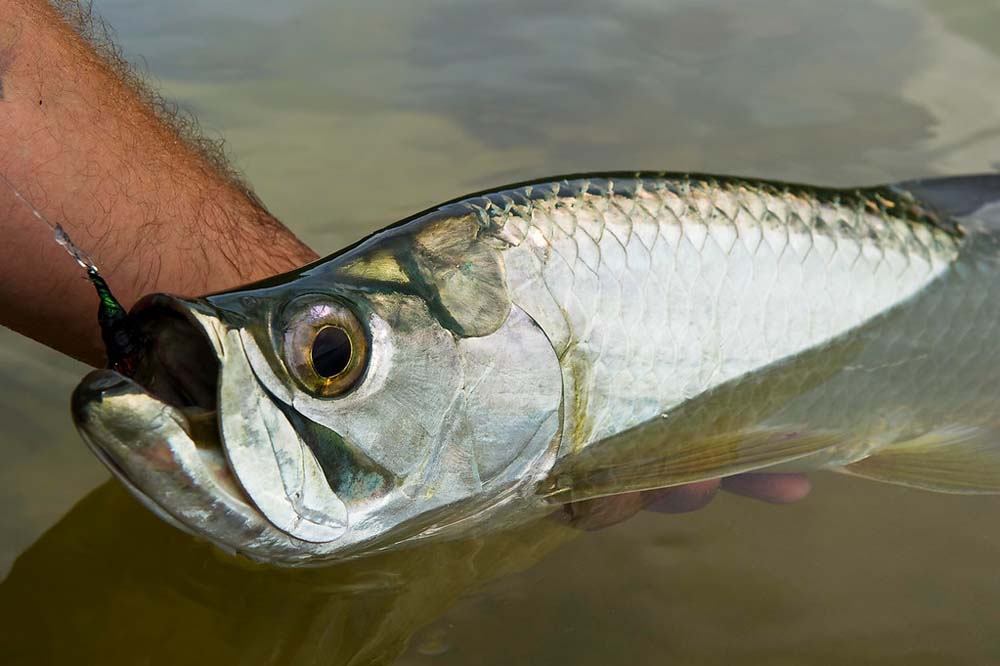
Ambergris Caye, Belize – a small tarpon shows up.
Photo: Jim Klug – Yellow Dog Flyfishing.
Strip set versus trout set
In the example of Pat Philbin and Caesar De La Hoya and their instinctual trout set, lifting the rod tip when feeling the bite is a non-starter in the salt. A high percentage of trout sets on saltwater fish like bonefish result in pulling the fly out of the fish’s mouth. Strip strike is the game changer. When the bone is a few yards away, and your fly is at benthic rest, give it a twitch, enough to stir up the bottom, wait for an aggressive response, and eat, or strip the fly +/- 6-inches a pull.
If, in either situation, you get a feel of connectivity, continue with one more strip; if you come tight, then a hard pull for a final sure-set and fish on.
The hardest part of the strip set is not to snap the line when the bonefish has taken the fly; that is why a second strip set is done. The hard set has to be measured, even guessed at, as appropriate, so do not have a handful of fly lines – just thumb and pointing finger. A hard set with that grip is plenty.
Clearing line
‘Fish On’ means clear your line immediately [under foot]; use off-hand to keep the line away from hanging up on clothes or attached accouterments [forceps, etc.], and more importantly, line wrapping around the fighting butt of the fly rod—the latter is, ‘The devil is in the details.’

Photo: Jim Klug – Yellow Dog Flyfishing.
Fly Rods
First, an expensive fly rod is unavoidable if you want to be a successful bonefish experience [good fly rod, happy angler]. That does not mean a $1,000 rod; a trip to your fly shop is recommended. There are plenty of good fly rods under $500.
A smaller fly shop might only stock or rep one or two fly rod companies, but they won’t be representing Walmart or big box store brands, and they will have sevens and eights for you to try on for size.
Two, a backup fly rod need will come into play sooner than later if you destination fish a few times a year. It is improvident to bring a crappy backup fly rod that cannot cast well even in windless conditions, ably cast bigger flies, or not be capable of harnessing even the smallest bonefish.
A noted bonefish angling friend brings three rods to her favorite destination. Seven [$400 to $700 rods] and two eights were $400 to $700 rods. The oldest is eight, and two eights are in the 4/5-year-old range.
Lastly, does a backup fly rod need to be almost as good as your first choice? Yes, but preferably just as good.
Reels
With assurance, guides and tournament-level bonefishers think the reel may be more important than the fly rod. Yes, decades ago, Florida Keys guides learned how to palm outgoing fly line on a bonefish [and tarpon], but today an amateur palming the runs of any flats fish is the quintessential meaning of bonehead.
Quality defines reels, and that is particular to its drag system. The latter quickly eliminates most reels. As a result, a China-made reel will flirt with price only. The high end of quality costs $2,200 [Mako] or $1,000 for a Seigler, and an equal for a quality bonefish reel is Nautilus [$625] and a few others like Lamson, Ross, 3Tand, and others
What the reel must do to be reliable
- A reel with a serious drag system keeps measured pressure at all times on running fish and, in particular, does not stall on startup, causing, for example, a 2-pound setting to be a 14-pound resistance for a nano-second and snapping a 12-pound test tippet. Game over.
- A poor drag system will always telltale it’s subpar on fish runs because it will start to pulse – in and out of the setting, which may snap the tippet.
When a bonefish [any fish] sees the boat and is only a few feet away from hand or net capture, it will make a bursting run, again testing the drag. A poor drag system will often recreate the startup issue previously mentioned – exceed the pound test setting for a second in time, and snap the tippet.
Backing
For bonefish anywhere in the world, and a surprise visitor like a tarpon or permit, there is no need for more than 250 yards of 20# dacron.
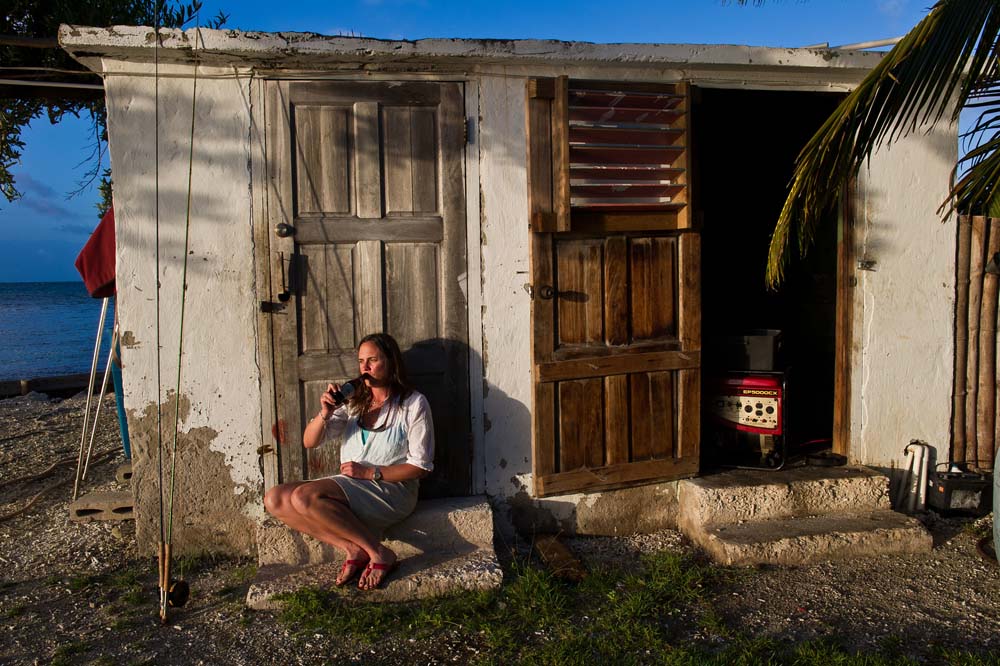
An Indian Ocean fly fishing guide/captain takes a break. Photo: Jim Klug – Yellow Dog Flyfishing.
Fly Lines
Bonefish do not like front-loaded, fat-headed lines, like A RIO Outbound Short fly line, preferring long-headed lines that best create undisturbing landings like RIO Premier Bonefish Fly Line and like quality lines from others. However, an entry-level caster, especially wade fishing in shallow water with a guide, could benefit from a front-loaded fly line like RIO’s Bonefish Quickshooter.
NOTE: Be quick to replace your fly line if it shows wear [small cracks, dry, stiff feel]. Also, take line cleaner with you in a bonefish expedition; salt build-up will happen in one day.
Leader build overview
Leaders’ build preferences are still subject to fealty. As far as I can tell, Lefty Kreh got fly fishers’ attention with ‘formulae’ leader builds with the leader butt X-pound test and Y-length, then half the length of the butt in the next section with a lesser diameter [pound test], and so on, then a tippet of lesser strength/diameter than its attached to – for bonefish that’s usually 8- to no more than 16-pound test mono.
Today, there are many iterations of Lefty’s formulae: Bruch Chard, Peter McLeod, Flip Pallot, Oliver White, Andrew Derr, Tom Karrow, Aaron Adams, Chico Fernandez, Sandy Moret, Angie Roth – all have theirs, and there are more, of course.
Popular across the board, though, are hard mono leaders like RIO Hard Mono Saltwater Tippet. It’s a very stiff, super abrasion-resistant nylon monofilament material and one of the easiest hard tippet materials to knot. Also, the step-down leader builds as described require, in some cases, as many as six joining knots [some think that’s an issue]. Usually, blood knots, except when joining the fluorocarbon tippet, become a diameter consideration, not a pound test. The diameter of 12-pound test monofilament is 0.35mm, and the equivalent fluorocarbon diameter is a 15-pound test. So a more substantial knot, Triple Surgeons, is required to tie monofilament to fluorocarbon.
Flies
NOTE: There are over 400 YouTube videos making mention of bonefish flies or having titles making ‘these’ 3, 5, 8, 10, 20 the best bonefish flies, and like many of today’s YouTubers who claim knowledge of best anything, too many are morons craving a place in the sun and as much knowledge and trustworthiness as some politicians.

Photo: Jim Klug – Yellow Dog Flyfishing.
Flies are a personal choice
However, it is accepted that a few flies with a history of success at multiple locations catching bonefish are the best way to travel. For example, a Mantis Shrimp fly, Bonefish Bitters fly, and the Gotcha fly tied in varying ‘eye’ weights, colors, and different sizes are better than arriving in the Seychelles, Bahamas, Belize, Mexico, or Honduras with a trunk full of bonefish flies.
Always carry some unweighted flies (Bonefish Special, Snapping Shrimp), medium-weighted flies (Bitters, Puffs, bead chain patterns), heavily weighted (lead yes, etc…), crab patterns, and Venezuela (baitfish patterns).
NOTE: Your guide/captain in the Bahamas, Mexico, Belize, and most other destinations will select the bonefish fly from your offerings or skip that altogether and hand you the day’s winner from his tying bench. You paid hard-earned money to be on a destination trip; pay attention to your guide. He knows far more than you ever will. So be open with your guide.







